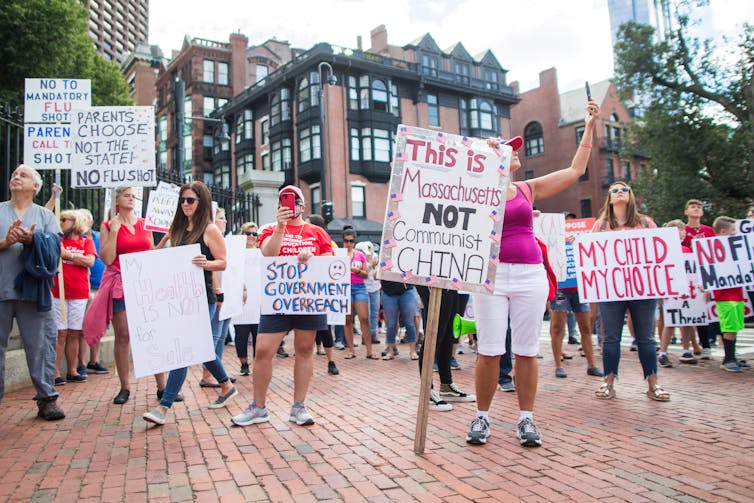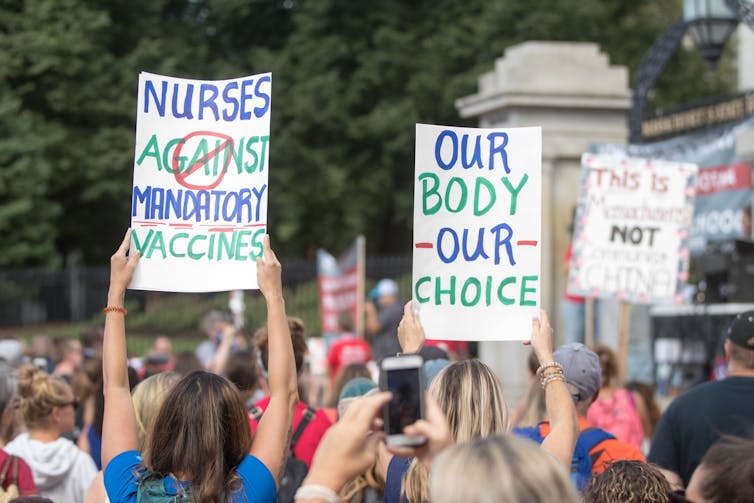Coronavirus vaccines: health experts identify ways to build public trust
- Written by Ann Christiano, Director, Center for Public Interest Communications, University of Florida
The pharmaceutical companies Pfizer and BioNtech announced Nov. 20, 2020, that they will seek emergency use authorization from the Food and Drug Administration[1] for a vaccine to prevent COVID-19. On Nov. 16, Moderna announced[2] that a vaccine it has been working on has been shown to be close to 95% effective.
But no vaccine will be nearly that effective in reality if people refuse to take it. And recent polls suggest that about 40%[3] of Americans won’t take a COVID-19 vaccine when it becomes available. Those numbers are even higher among nonwhite Americans[4].
The factors that lead people to make choices to take vaccines are nuanced. People’s choices are affected by how they see the world[5], their perceptions of the choices people like them will make, whom they trust, their perceptions of risk, consistency of message and convenience of actually getting the vaccine.
 Polls suggest millions of Americans won’t take the COVID-19 vaccine.
Scott Eisen via Getty Images[6]
Polls suggest millions of Americans won’t take the COVID-19 vaccine.
Scott Eisen via Getty Images[6]
In a world with unlimited supplies of vaccine and budget to support outreach, public officials could craft highly specific campaigns for each community and identity in the world. The vaccine would be simultaneously available to everyone, and our personal doctors would administer it and assure us of its efficacy.
That world doesn’t exist.
Melissa Fleming, the United Nations undersecretary general for global communications, recently launched the Verified initiative[7] to combat misinformation about COVID-19. Verified engaged the Center for Public Interest Communications at the University of Florida. Our team of scholars, strategists and storytellers works with organizations around the world to apply social, behavioral and cognitive science to drive lasting social change. We were asked to identify research-based messages that might overcome vaccine hesitancy. Verified released our guide Thursday[8].
We quickly identified the leading scholars in this space, and 16 social and behavioral psychologists, medical anthropologists, behavioral economists, neuroscientists and political communications scholars joined us for a series of conversations over five days. We asked questions like: What makes people resilient against misinformation? What drives vaccine hesitancy? Which frames will be most effective? What kinds of message strategies have been effective with specific communities? And finally, what are some of the best ways to make taking the vaccine a social norm?
 Although many Americans say they will refuse the COVID-19 vaccine, there are ways to increase acceptance.
Scott Eisen via Getty Images[9]
Although many Americans say they will refuse the COVID-19 vaccine, there are ways to increase acceptance.
Scott Eisen via Getty Images[9]
Eight principles emerged from those conversations that we believe can increase trust, acceptance and demand for vaccination. We have shared these principles with the leaders across the U.N. as part of their global efforts to reduce vaccine hesitancy and overcome misinformation related to COVID-19.
Work within worldviews, identities and moral values. Each of us has a unique set of identities, worldviews and moral values that influence our choices and behaviors, and even what we believe to be true. It’s worthwhile to understand what others see as right and wrong and to connect with what’s most important to them[10]. Find the common ground between what you hope to achieve and what matters to them. For example, taking a vaccine, then, would become a way to return to activities and behaviors[11] that matter most to them.
Use timing to the best advantage. It’s far easier to build trust when you’re the first to articulate a message. People are most likely to trust – and stick to – the version of information they hear first[12]. It’s equally important, however, that they hear that same message multiple times from an array of sources[13].
Use the right messengers for the audience. People act when they trust the messenger, the message and their motivations. Trusted messengers vary greatly from community to community[14], but there are some broad lessons you can apply. Ideally, the messenger is someone with deep expertise: a doctor, a scientist or a public health practitioner. But trusted messengers are also those in our “in-groups,” people we see as being like us and who share our values. As behavioral economist David Fetherstonhaugh put it, “I couldn’t stress enough the importance of a message coming from within an in-group — someone that’s automatically on the inside. It’s almost like such messages even bypass deliberate cognition because they are coming from a trusted source: ‘They’re my family, or it’s my pastor, or it’s my party leader.’ So the source of a message, in-group vs. out-group, is extraordinarily important for how a message is received.”
Make the content concrete[15], supply a narrative and provide value. If messages aren’t concrete and don’t include stories, our powerful sense-making brains will fill the abstraction with stories and ideas that make sense to us. One particular space to build that narrative is around vaccine trials. Instead of saying “we’re in stage 3,” name the number of people who have participated in successful trials and share stories of individuals who participated in those trials.
Recognize that communities have different relationships with vaccination[16]. In some societies, people may be fearful of vaccines, but have a strong trust in authority. In others, mandatory vaccinations have created distrust of government authorities. In others, decades of mistreatment and exploitation[17] have resulted in a profound lack of trust in new medical treatments[18]. Different societies also have different relationships with authority. In societies where people trust authority, they’re more likely to accept direction even if they don’t support it.
Reinforce positive behaviors. We are deeply affected by the behavior and choices of people in our networks – even people we may not have met[19]. So to change behavior, you have to shift people’s perceptions of what normal behavior looks like. Examining vaccine hesitancy through the lens of social norms offers two opportunities to make a difference. The first is activating trusted influencers within social networks and people’s perceptions of what others are doing. The second is in shifting the communications norms among those communicating on behalf of the vaccine.
Evoke the right emotions. It’s tempting to activate emotions like fear or shame to get people to take a vaccine, but it’s unlikely to work. Fear immobilizes people, and shame is likely to achieve the wrong reaction. Look to more constructive emotions like awe, hope and parental love to get people to act.
Be explicit and transparent about motivations. Our perceptions of the motivations of the messenger matters. Our motivations in seeking information are equally important. We’re less likely to trust a vaccine if we question the motives of the people advocating for us to take it.
There is, of course, a weakness in this tool, which is that it’s based on research conducted on hesitancy around other vaccines. We don’t know about COVID-19, because we don’t yet have the vaccine. But even with these obvious limitations, science-informed messages are the best tools we have.
[Research into coronavirus and other news from science Subscribe to The Conversation’s new science newsletter[20].]
References
- ^ seek emergency use authorization from the Food and Drug Administration (www.cnn.com)
- ^ Moderna announced (www.nytimes.com)
- ^ about 40% (news.gallup.com)
- ^ nonwhite Americans (news.gallup.com)
- ^ by how they see the world (theconversation.com)
- ^ Scott Eisen via Getty Images (www.gettyimages.com)
- ^ Verified initiative (shareverified.com)
- ^ guide Thursday (covid19vaccinescommunicationprinciples.org)
- ^ Scott Eisen via Getty Images (www.gettyimages.com)
- ^ see as right and wrong and to connect with what’s most important to them (shotofprevention.com)
- ^ a way to return to activities and behaviors (www.theguardian.com)
- ^ the version of information they hear first (www.bbc.com)
- ^ hear that same message multiple times from an array of sources (www.centerforhealthsecurity.org)
- ^ vary greatly from community to community (www.centerforhealthsecurity.org)
- ^ content concrete (theconversation.com)
- ^ different relationships with vaccination (www.statnews.com)
- ^ decades of mistreatment and exploitation (doi.org)
- ^ profound lack of trust in new medical treatments (www.scientificamerican.com)
- ^ even people we may not have met (tech.winningbrain.com.ng)
- ^ Subscribe to The Conversation’s new science newsletter (theconversation.com)
Authors: Ann Christiano, Director, Center for Public Interest Communications, University of Florida

